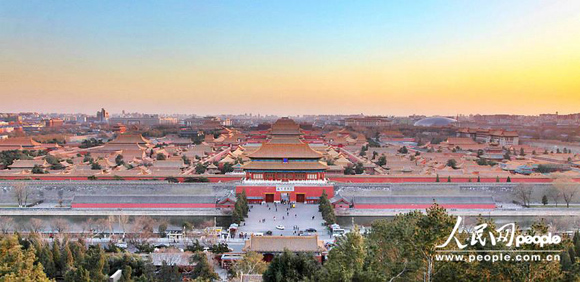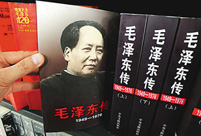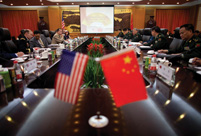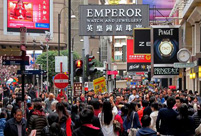 'Jin' named the word of the year by cross-strait netizens
'Jin' named the word of the year by cross-strait netizens Chinese scientific expedition goes to build new Antarctica station
Chinese scientific expedition goes to build new Antarctica station
 Chinese naval escort fleet conducts replenishment in Indian Ocean
Chinese naval escort fleet conducts replenishment in Indian Ocean 17th joint patrol of Mekong River to start
17th joint patrol of Mekong River to start China's moon rover, lander photograph each other
China's moon rover, lander photograph each other Teaming up against polluters
Teaming up against polluters

Photos of the Forbidden City that are taken at the same location to record the air quality change in six successive days from Nov. 2 to Nov. 7, 2013. (People’s Daily Online/ Weng Qiyu)
"To expand forest, lake and wetlands in urban areas, to make mountains and rivers visible in the cities, and to let people remember the old times." The statement summarized a high-level conference, which spoke out about people's expectations, and where experts forecast that China's urbanization may help to bring relief to smog-bound cities.
The leadership conference concluded on Dec. 16 by producing a blueprint for urbanization and highlighting that China’s future development will be based on promoting social justice and common prosperity. The conference stated that urbanization will bring benefits to economic development and to the ecological environment at home and further afield.
According to the China Meteorological Bureau, figures covering 25 provinces and more than 100 cities show that this year China has had the most smog days in the last 52 years, and 13 regions hit record high levels of air pollution. Lingering smog has caused increasing public concern. 
17 provinces and regions suffered severe smog in 2013, representing 25% of national territory and affecting about 600 million people.
Experts point out that adverse weather conditions, automobile exhausts and high consumption of energy from industry are the main contributors to air pollution. Moreover, overcrowded population centers and dust from construction projects accelerate the production of smog. They stress that China must take effective measures to tackle smog immediately.
"The Conference proposed the idea of 'letting people see more green'. With space for construction limited, villa-style, large-scale buildings will no longer be a common feature in residential construction, so more space will be left for green," said Yi Peng, a researcher from the China Center for Urban Development under the National Development and Reform Commission.
The conference urged the country to make priorities of environmental security, expansion of forests, lakes and wetlands, and enhancement of water conservation.
Yi said that urbanization should bring nature back to the cities, and let people live in a more natural environment. Urbanization should curb its extremes, accommodate nature, and leave more space available for greening.
The conference statement also proposed increasing energy efficiency, and cutting energy consumption and carbon dioxide emissions, which Yi described as clear signs of the importance of urbanization development, and measures which will help to relieve air pollution.
According to Yi, the purpose of urbanization is to concentrate populations in urban areas in order to limit overall energy consumption and emissions. 
68.4% of energy consumption came from coal in 2011.
"The truth is that coal is China's primary energy source. We need to be thinking about using natural gas, solar energy, wind power and other renewable energy substitutes for coal usage," said Bai Yunfeng, deputy chief of the National Environmental Protection and Coal-burning Control and Technology Center.
"Smog mainly affects developed regions which are at the stage of post-industrialization. In the past many cities adopted industry-led models in the course of urbanization, leading to severe air pollution," said Wu Bihu, director of the Center for Recreation and Tourism Research at Peking University. "Scientific and low-carbon usage of resources should be encouraged, and service industries will become an important feature of the new model of urbanization."
The Palace Museum under the blue sky. (People's Daily Online/Wang Chu)
 Commemorate 120th birth anniversary of Mao Zedong
Commemorate 120th birth anniversary of Mao Zedong Female soldiers of PLA Marine Corps in training
Female soldiers of PLA Marine Corps in training Chinese cities to have a very grey Christmas as smog persists
Chinese cities to have a very grey Christmas as smog persists China and U.S. - the national image in each other’s eyes
China and U.S. - the national image in each other’s eyes The Liaoning's combat capability tested in sea trial
The Liaoning's combat capability tested in sea trial Chinese pole dancing team show their moves in snow
Chinese pole dancing team show their moves in snow Rime scenery in Mount Huangshan
Rime scenery in Mount Huangshan Ronnie O'Sullivan: My children mean the world to me
Ronnie O'Sullivan: My children mean the world to me Shopping in Hong Kong: a different picture
Shopping in Hong Kong: a different picture The buzzwords in 2013
The buzzwords in 2013 Top 10 domestic news of 2013
Top 10 domestic news of 2013 Red crabs begin annual migrations in Australia
Red crabs begin annual migrations in Australia Artifacts retrieved from West Zhou Dynasty
Artifacts retrieved from West Zhou Dynasty Aftermath of Volgograd railway station blast
Aftermath of Volgograd railway station blast Fleet hits targets in training
Fleet hits targets in trainingDay|Week|Month